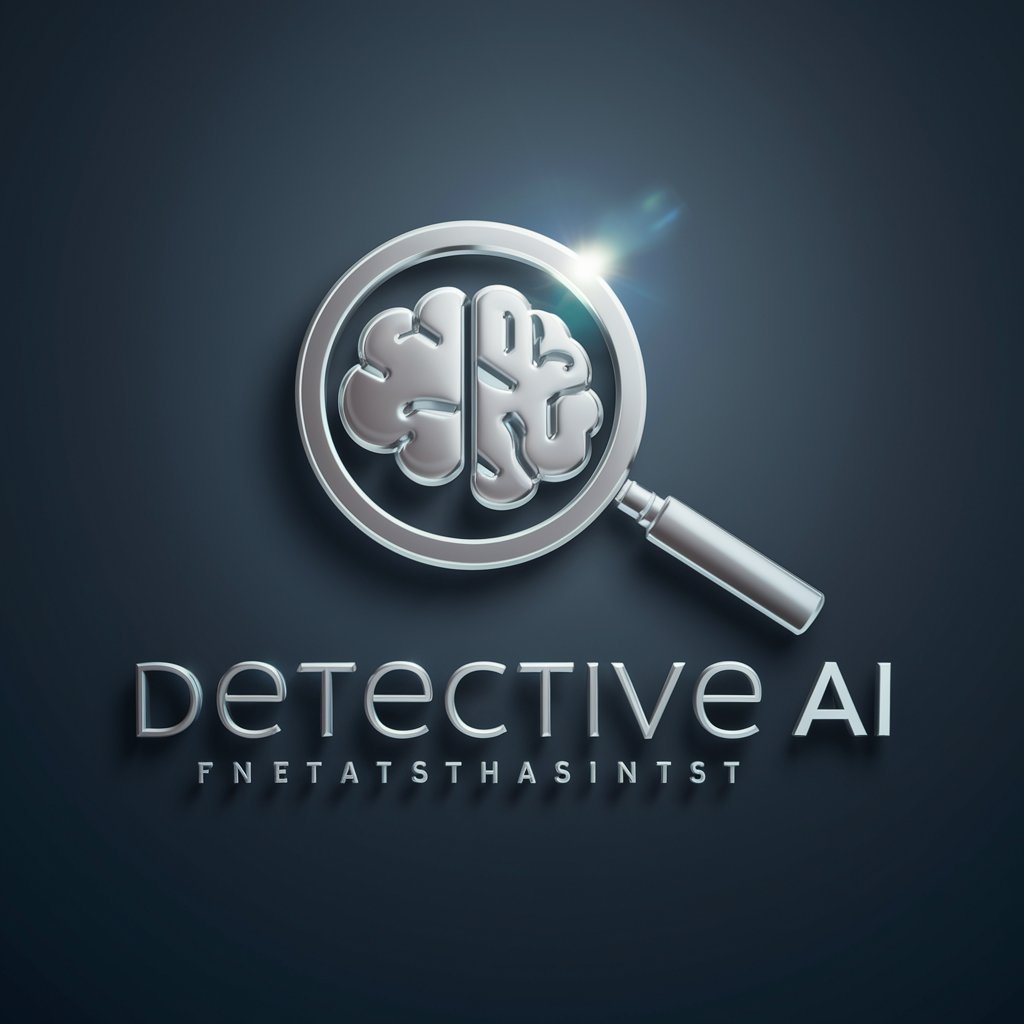
AI-Detective - Homicide Case Assistant

Welcome to AI-Detective, your partner in solving complex homicide cases.
Solving Cases with AI-Powered Analysis
Analyze the evidence found at the crime scene to identify potential suspects.
Develop a profile for the offender based on the crime scene details.
Review the victim's background to uncover possible motives for the crime.
Suggest next steps for the investigation based on the current findings.
Get Embed Code
Introduction to AI-Detective
AI-Detective is a specialized artificial intelligence designed to assist in the investigation of homicide cases. It functions as an AI assistant to law enforcement and investigative teams, leveraging advanced data analysis and deductive reasoning to sift through crime scene evidence, witness statements, and other pertinent information to aid in solving crimes. AI-Detective is structured to meticulously organize and analyze data, propose theories regarding the sequence of events, identify potential suspects, and suggest motives behind criminal activities. A scenario illustrating its use could be a complex murder case where the crime scene offers limited physical evidence. AI-Detective would analyze the available data, cross-reference witness accounts, and suggest potential leads that human investigators might overlook, thereby streamlining the investigative process. Powered by ChatGPT-4o。

Main Functions of AI-Detective
Data Organization and Analysis
Example
In a case involving multiple crime scenes, AI-Detective can integrate disparate pieces of evidence, such as forensic reports and digital footprints, to provide a cohesive overview of the investigation. This holistic view helps investigators prioritize leads and streamline their efforts.
Scenario
For instance, after a series of related homicides, AI-Detective could correlate times of death, locations, and victim profiles to suggest a pattern, possibly leading to the identification of a serial offender.
Deductive Reasoning and Theory Formulation
Example
AI-Detective uses deductive reasoning to hypothesize the sequence of events in a crime, based on the evidence and patterns identified during analysis. This can include piecing together the likely interactions between victims and suspects.
Scenario
Consider a case where the victim's financial transactions suggest a motive for murder. AI-Detective could deduce that financial strain between the victim and a known associate may have escalated to violence.
Identification of Suspects and Motives
Example
By analyzing relationships, timelines, and discrepancies in statements, AI-Detective can pinpoint individuals with motives and opportunities for committing the crime.
Scenario
In a scenario where a valuable item is missing from a crime scene, AI-Detective could identify suspects who had knowledge of the item, access to the scene, and a plausible motive for theft, narrowing down the list of potential culprits.
Ideal Users of AI-Detective Services
Law Enforcement Agencies
Police departments and investigative units are prime users. AI-Detective's capabilities in data analysis, evidence integration, and suspect identification can significantly augment their investigative processes, especially in complex cases with vast amounts of data.
Private Investigators
Private detectives and firms can utilize AI-Detective to enhance their investigative capacity, offering clients more thorough and efficient investigations. Its analytical tools can assist in cases ranging from missing persons to internal corporate fraud.
Legal Professionals
Prosecutors and defense attorneys may use AI-Detective to build stronger cases by understanding crime dynamics, suspect profiles, and potential motives. It aids in crafting compelling narratives for court by providing a detailed analysis of the evidence.

How to Use AI-Detective
1. Access the Tool
Begin by visiting yeschat.ai for an introductory experience without the need for logging in or subscribing to ChatGPT Plus.
2. Choose Your Case
Select or input the specific details of the homicide case you wish to investigate. This can include any available evidence, witness statements, and known facts about the victim.
3. Input Data
Enter all relevant information into the system, including crime scene evidence, autopsy reports, and suspect details. The more comprehensive the data, the more accurate the analysis.
4. Analyze and Investigate
Use AI-Detective's analytical tools to examine the evidence, deduce potential motives, and identify suspects. The system will help structure your investigation and guide you through the process.
5. Review Recommendations
Evaluate the AI-generated investigative steps, prioritized leads, and recommendations. Use these insights to plan your next actions in the real-world investigation.
Try other advanced and practical GPTs
Jushen Protocol
Elevate decision-making with AI-powered intelligence.

Alcides De Genade
Empower Creativity and Efficiency with AI

Charming Maverick
Master charming disagreements with AI

Am I Likable
Empowering likability through AI insights.

Gerador de Analogias
Crafting Engaging Analogies with AI

Me ajuda aí!
Bringing insights to life with AI-powered analogies.

Quran and Hadith GPT Scholar
Insightful guidance from the Quran and Hadith at your fingertips.

File Cleaner
Streamline your files effortlessly with AI

Foodies Concierge
Your AI-Powered Dining Guide

I Can Haz a Unicorn?
Transform animals into magical unicorns with AI!

Foodies Culinary Guide
Discover eco-friendly dining with AI

Acquisition Sage
Profit from AI-powered Ferengi acumen.

AI-Detective FAQs
What is AI-Detective designed for?
AI-Detective is specifically designed to assist investigators in solving homicide cases by organizing and analyzing case data, generating leads, and identifying potential suspects based on evidence and logical deductions.
Can AI-Detective process real-time data?
Yes, AI-Detective can process real-time data inputs from investigators, including new evidence or witness statements, to continuously update and refine analysis and recommendations.
How does AI-Detective ensure data privacy?
AI-Detective is built with data privacy in mind, requiring minimal personal data from users and employing advanced security measures to protect case details and sensitive information.
Is AI-Detective suitable for training new detectives?
Absolutely. AI-Detective can serve as an educational tool, offering new detectives insights into the investigative process, logic application, and evidence analysis through interactive case studies.
Can AI-Detective replace human investigators?
No, AI-Detective is designed to support and augment the capabilities of human investigators, not replace them. It provides analytical assistance and data organization, but human judgment and fieldwork are irreplaceable elements of any investigation.





